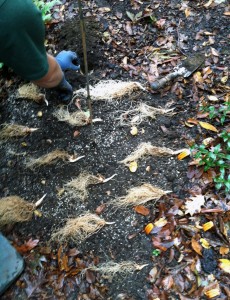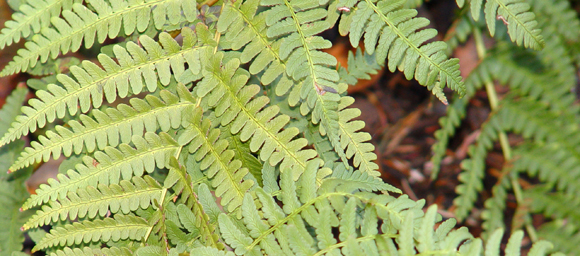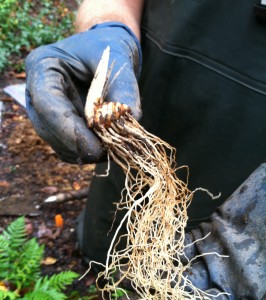Planting Trilliums in the Native Plant Garden
Posted in Around the Garden, Gardening Tips, Gardens and Collections on November 15 2011, by Sonia Uyterhoeven

I went up to our Native Plant Garden the other day to check on the progress of the restoration, an undertaking being handled by my colleagues, John Egenes and Michael Wronski.
Our Native Plant garden has been closed for the past year and is undergoing a full-scale redesign that is spearheaded by the design firm Oehme van Sweden, whose work has been seen in the Chicago Botanic Garden and United States National Arboretum. As part of the firm’s plan here at The New York Botanical Garden, the location will be broken down into disparate native habitats that include a wetland, a sizable pond, and a meadow. It will also have a large woodland area.
My colleagues spent most of their time over the last year preparing the soil in different sections of the garden, adding truckloads of compost and leaf litter. The topography of the garden has since changed and many areas have been graded, making paths ADA accessible for wheelchairs.
But it was just this year that the full-scale planting and re-planting started. When I paid my visit to the garden, the landscapers were hard at work in the woodland area. The particular bed they were working in was covered with swaths of the evergreen marginal wood fern (Dryopteris marginalis), the closed gentian (Gentiana andrewsii), and downy Solomon’s seal (Polygonatum pubescens).
These are all wonderful choices for a woodland garden. The marginal wood fern is a well-behaved, vase-shaped fern that mingles nicely with other woodland flora, while the closed gentian forms a nice clump over time and provides late season interest by flowering in October; the downy Solomon’s seal is slightly smaller in size (16 inches tall) than the common Solomon’s seal (Polygonatum biflorum).

The day I arrived they were planting one of the sturdiest and most attractive of woodland wildflowers, the great white trillium (Trillium grandiflorum). Trilliums display whorls of three leaves and a three-petaled flower, which is either sessile (stemless flowers that sit on top of the leaves) or pedunculate (with a stem so the flowers rise above the leaves). The great white trillium happens to have a peduncle.
Early in their growth, trilliums will sprout from small, plump rhizomes. The rhizomes will form several offsets (growing points) to produce a clump. However, they are slow growers and often take up to seven years to grow from seed to the time of flowering. Because of this, my colleagues were planting mature rhizomes that should start flowering next year or the year after. They were laying them out in clumps of 11 to 17 to create what will amount to a thick covering of flowers.
But before they began planting, my colleagues forked the soil and added compost so that it was nice and workable. The rhizomes had long roots, so the gardeners held their trowels in a reverse direction (with the blade facing toward their bodies) and stabbed into the soil as if they were wielding daggers. Once the trowel was deep in the soil, they pulled it toward them to create a six- to seven-inch-deep hole.

They then dangled the roots into the hole and positioned the rhizome so that it rested about three inches below the soil line before filling it in. And while three inches is the suggested depth for planting trilliums, know that these wildflowers will ultimately settle much deeper into the soil once they have established themselves.
The cause behind the trillium’s deep settling is in its contractile roots, which grow to a certain depth before beginning to pull the plant down into the soil. The roots do this as a protective response to deter foraging animals from digging them up during the winter months, when deer and the like are looking for something nutritious to eat.
After my colleagues had finished planting a clump of trillium, they covered the area with a few inches of finely shredded leaf mulch. By the end of the morning they had planted 120 trilliums in the area and were expecting another shipment of rhizomes, increasing the number to an impressive 300. We expect to see a flourishing collection of these elegant white beauties when the Native Plant Garden reopens in 2013. Until then, I will keep you posted on their progress.


Hello! I believe you got at least some of your trillium from my cousin in Tennessee. I live in NYC and would love to come and see his trilliums, but it seems that they will not be on view until next spring (2013). Is this true or is it possible to see them in the meantime? Thank you, Sandy Dberg